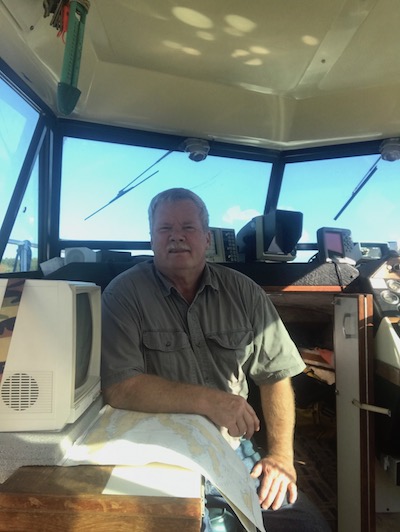When Bernie Hellstrom picked up an obstruction on his boat's
sounder, he knew something big was there, but he had no idea how historic it
was — or that he would discover it with an IBEW brother.
"I was just thinking, 'Let's see what's here,'" Hellstrom said. "I had no idea at the time of the historical significance."
What Hellstrom found was the crash site of two Civil War-era ships previously thought to have sunk in another part of the Great Lakes.
Hellstrom, a Traverse City, Mich., Local 498 retired journeyman wireman, has long been a fan of the lakes. He even considered becoming a commercial diver as a young man.
"I was always in the water. I was diving before I was driving," said Hellstrom, who was born in the Detroit area but moved to the west side of the state as soon as he could to better enjoy the lakes. His current hometown, Boyne City, is in the northwest corner of Michigan's lower peninsula and gives him easy access to Lake Michigan.
A longtime shipwreck and Great Lakes enthusiast, Hellstrom has been monitoring the waters of Lake Michigan for years. In 1995 he was in charge of operations on a dive to the Carl D. Bradley, a ship that sank in 1958 some 380 feet below the surface.
Part of that expedition was made possible by Hellstrom's homemade underwater camera, which Popular Science described as "ingenious."
As Hellstrom noted, back in the '90s there were very few underwater cameras available to people outside of universities or other specialized places. But with his IBEW training, he was able to make one from salvaged home security system parts and house it in a pressure-resistant watertight case.

|
Traverse City, Mich., Local 498 retiree Bernie Hellstrom on his boat. Photo credit: deAnna Hellstrom
Photo credit: deAnna Hellstrom
|
"They were amazed at what could be done with low-cost equipment," Hellstrom said.
That camera, which can reach a depth of 1,000 feet, has served him well as he checks off potential Great Lakes shipwrecks from his bucket list.
The largest group of freshwater lakes in the world by total area, the Great Lakes have a history of marine transportation dating back to the 17th century, though traversing the waters has never been easy. Roughly 6,000 ships have sunk over the years, though one historian puts the figure as high as 25,000. Nearly 30,000 people have died in those shipwrecks, according to the Great Lakes Shipwreck Museum.
"Having the sea-like features such as rolling waves, strong currents and great depths, these water bodies, also known as inland seas, offer a difficult time for sailors when traversing through the region," wrote Marine Insight.
So it wasn't uncommon for the trading vessels the Peshtigo and the St. Andrews to collide when they did on a dark and hazy night on June 25, 1878. Built in 1863 and weighing 384 tons, the Peshtigo was considered a giant ship at the time, with three masts and a length of 161 feet. The St. Andrews, built in 1857, was almost as long at 143 feet long with a weight of 426 tons.
The St. Andrews was bound from Chicago to Buffalo, N.Y., with a cargo of corn, while the Peshtigo was bound from Erie, Pa., to Chicago with coal, which is now strewn along the bottom of the lake.
What wasn't as common though, was for the two schooners to sink 200 feet to the bottom of Lake Michigan and come to rest only about 10 feet apart.
"That's very close. That's like a needle in a haystack," said St. Paul, Minn., Local 110 member and diver John Scoles, whom Hellstrom called when he picked up the signal.
The IBEW brothers met through their shared interest in diving. Scoles, who also shoots video, happened to have an IBEW sticker on a piece of his equipment that Hellstrom noticed.
"It's nice to meet a fellow electrician," Scoles said. "Bernie's a great guy. He's a comedian."
Hellstrom made the discovery in June while he was on his boat between Beaver Island and Fox Island, not far from his home near the northern part of Lake Michigan.
"It was an exciting find, not at all what I expected initially," Hellstrom told the Michigan Building Trades newspaper.
Until Hellstrom's discovery, the collision was thought to have occurred some 50 miles to the east, closer to the Straits of Mackinac. But with the help of Scoles and another diver, John Janzen, and their underwater photos and video, historian Brendon Baillod reexamined the site and concluded that the two Civil War-era ships did indeed sink where Hellstrom found them.
"If you think about it, cities like Chicago, Detroit and Milwaukee would never have been able to develop without the water highway," said Cathy Green, executive director of the Wisconsin Maritime Museum in Manitowoc, to the Los Angeles Times. "When material remains of that history is found, it's a big deal to historians and archaeologists."
Shipwreck World noted that the sites are now considered important historical and archaeological resources and are protected by Michigan law from salvage or diver impact.
Hellstrom and Scoles say they are hoping to return to the area for more exploration in June of next year, weather permitting.